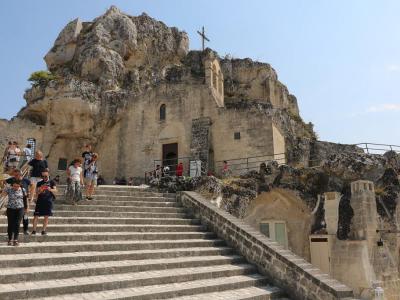Chiesa di Santa Maria di Idris (Church of Saint Maria of Idris), Matera (must see)
The Church of Saint Maria of Idris is a rupestrian church in Matera. It is carved into a limestone rock of Monterrone that dominates the Sasso Caveoso. The beautiful location offers a unique view of the city. The church can be reached via stairs to the rock Church of Santa Lucia alle Malve. "Idris" is derived from the Greek "Odigitria," "who shows the way."
A facade of masonry is next to a small bell tower. The interior nave is uneven. Some frescoes have been removed for restoration. Once restored, they are kept at the Superintendency for Historical and Artistic Heritage of Matera. On the altar is a 17th-century tempera rendering of the Madonna and Child.
Santa Maria de Idris is connected to the rock crypt of San Giovanni in Monterrone via a tunnel. The tomb holds several precious frescoes from the 12th to the 17th century. A fresco of John the Baptist is in the tunnel. In a lunette above the crypt is a 12th-century Christ Pantocrator. The title is Greek, meaning "All-Powerful."
After the corridor is a large hall, a nave of San Giovanni in Monterrone. On the wall of the presbytery is a 12th-century Madonna and Child, Glykophilousa style (Virgin of the Sweet Kiss). Other saints stand in decorated niches.
A facade of masonry is next to a small bell tower. The interior nave is uneven. Some frescoes have been removed for restoration. Once restored, they are kept at the Superintendency for Historical and Artistic Heritage of Matera. On the altar is a 17th-century tempera rendering of the Madonna and Child.
Santa Maria de Idris is connected to the rock crypt of San Giovanni in Monterrone via a tunnel. The tomb holds several precious frescoes from the 12th to the 17th century. A fresco of John the Baptist is in the tunnel. In a lunette above the crypt is a 12th-century Christ Pantocrator. The title is Greek, meaning "All-Powerful."
After the corridor is a large hall, a nave of San Giovanni in Monterrone. On the wall of the presbytery is a 12th-century Madonna and Child, Glykophilousa style (Virgin of the Sweet Kiss). Other saints stand in decorated niches.
Want to visit this sight? Check out these Self-Guided Walking Tours in Matera. Alternatively, you can download the mobile app "GPSmyCity: Walks in 1K+ Cities" from Apple App Store or Google Play Store. The app turns your mobile device to a personal tour guide and it works offline, so no data plan is needed when traveling abroad.
Chiesa di Santa Maria di Idris (Church of Saint Maria of Idris) on Map
Sight Name: Chiesa di Santa Maria di Idris (Church of Saint Maria of Idris)
Sight Location: Matera, Italy (See walking tours in Matera)
Sight Type: Religious
Guide(s) Containing This Sight:
Sight Location: Matera, Italy (See walking tours in Matera)
Sight Type: Religious
Guide(s) Containing This Sight:
Walking Tours in Matera, Italy
Create Your Own Walk in Matera
Creating your own self-guided walk in Matera is easy and fun. Choose the city attractions that you want to see and a walk route map will be created just for you. You can even set your hotel as the start point of the walk.
Matera Introduction Walking Tour
Architectural historian Anne Parmly Toxey said the cave areas of Matera had been occupied for at least 3,000 years. Archaeological research shows people lived here since the Paleolithic era, shaping homes and communal spaces directly into the soft limestone. Over centuries, those modest caves expanded into an intricate neighborhood-stone dwellings, churches, and twisting passageways stacked upon... view more
Tour Duration: 2 Hour(s)
Travel Distance: 2.4 Km or 1.5 Miles
Tour Duration: 2 Hour(s)
Travel Distance: 2.4 Km or 1.5 Miles
Matera's Ancient Cave Churches
Within the old city of Matera, there are more than 160 churches. Many of these are actually carved into the soft limestone cliffs lining the Gravina River. There are even some used for pagan rituals. The churches were carved from existing caves and tunnels. More than a few sanctified cave churches have been converted to storage and homes.
A good example to start with is the St. Anthony... view more
Tour Duration: 1 Hour(s)
Travel Distance: 1.7 Km or 1.1 Miles
A good example to start with is the St. Anthony... view more
Tour Duration: 1 Hour(s)
Travel Distance: 1.7 Km or 1.1 Miles





